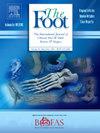Increased Achilles tendon force required to achieve heel-lift in cadaveric model of midfoot instability - A cadaveric study
Q2 Health Professions
引用次数: 0
Abstract
The progressive ligament instability associated with flatfoot deformity may result in altered foot biomechanics and represent a risk factor for the development of Achilles Tendinopathy (AT). The aim of this study was to determine whether an increased tendo-Achilles (TA) force was required to generate a set heel lift in a cadaveric flatfoot model. Thirteen fresh (previously frozen) cadavers, with no previous foot pathology and sectioned from the knee were mounted on a testing frame. The frame maintained a dorsiflexed ankle position, to simulate the terminal stance phase of gait, and allowed a constant axial load to be applied through the tibia. The heel was elevated 3 cm by a measured traction force through the TA to a pre-determined laser mark. The flatfoot model was created by sequential sectioning of the medial arch supporting structures, creating progressive midfoot instability and flatfoot deformity, from mild to severe. The force (N) required to generate heel lift was recorded at each stage of the development of the flatfoot. Initially, following Spring ligament and Tibialis Posterior sectioning, the force required to generate heel lift decreased. However, as the flatfoot deformity progressed the force required for heel lift increased. A severe flat foot deformity, characterised by medial ray destabilisation significantly increased the force required to generate a heel lift (5.1 ± 7.2 N, p = 0.02) as did sectioning of the (ii) short and long plantar ligaments (5.5 ± 8.7 N, p = 0.03). Progressive ligament failure associated with acquired flatfoot deformity may be a risk for AT overload due to increased TA force required for heel lift, resulting in TA overload symptoms. The paradoxical decrease in force required to generate heel lift with isolated SL sectioning has not been previously described. This biomechanical study raises the possibility that interventions that support the medial longitudinal arch, such as orthotics, may protect against TA overload.
在足中部不稳定的尸体模型中,需要增加跟腱力来实现脚跟抬起-一项尸体研究
与扁平足畸形相关的进行性韧带不稳定可能导致足部生物力学改变,并代表跟腱病(AT)发展的危险因素。本研究的目的是确定在尸体平足模型中,是否需要增加腱-跟腱(TA)力来产生固定的脚跟抬升。13具新鲜的(先前冷冻的)尸体,没有先前的足部病理,从膝盖上切片,被安装在一个测试框架上。框架保持踝关节背屈的位置,以模拟步态的最终站立阶段,并允许通过胫骨施加恒定的轴向负荷。通过测量的牵引力通过TA将脚跟抬高3 cm至预先确定的激光标记。平足模型是通过对内侧足弓支撑结构的连续切片来创建的,造成了从轻微到严重的渐进式足中部不稳定和平足畸形。在平足发展的每个阶段记录产生脚跟升力所需的力(N)。最初,在弹簧韧带和胫骨后切开术后,产生足跟抬升所需的力减小了。然而,随着扁平足畸形的进展,抬足所需的力增加。平足严重畸形,特点是内侧雷不稳定的显著增加所需的力产生一个脚跟抬起( 5.1±7.2 N, p = 0.02)一样的切片(ii)短期和长期足底韧带( 5.5±8.7 N, p = 0.03)。进行性韧带衰竭与后天性扁平足畸形相关,可能会增加足跟抬高所需的髋部力,从而导致髋部超载症状。以前没有描述过孤立的SL切片产生足跟举升所需的力的矛盾降低。这项生物力学研究提出了一种可能性,即支持内侧纵弓的干预措施,如矫形器,可以防止TA过载。
本文章由计算机程序翻译,如有差异,请以英文原文为准。
求助全文
约1分钟内获得全文
求助全文
来源期刊

Foot
Health Professions-Podiatry
CiteScore
2.00
自引率
0.00%
发文量
37
期刊介绍:
The Foot is an international peer-reviewed journal covering all aspects of scientific approaches and medical and surgical treatment of the foot. The Foot aims to provide a multidisciplinary platform for all specialties involved in treating disorders of the foot. At present it is the only journal which provides this inter-disciplinary opportunity. Primary research papers cover a wide range of disorders of the foot and their treatment, including diabetes, vascular disease, neurological, dermatological and infectious conditions, sports injuries, biomechanics, bioengineering, orthoses and prostheses.
 求助内容:
求助内容: 应助结果提醒方式:
应助结果提醒方式:


